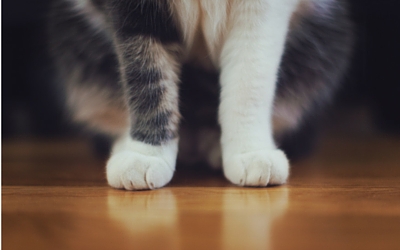Cat Paw Socks With Pads Toe Beans
 Although lowly in position, your cat's feet occupy a top spot in importance. How can a cat navigate the world without the support of four healthy tootsies? And the pads on the bottom of those feet are where "the rubber meets the road"!
Although lowly in position, your cat's feet occupy a top spot in importance. How can a cat navigate the world without the support of four healthy tootsies? And the pads on the bottom of those feet are where "the rubber meets the road"!
These pads are the thick, rubbery part of the cat's foot that cushion every step and provide traction to prevent slipping. Foot pads protect bones and joints from shocks incurred by running, walking or pouncing. They also insulate the foot from extreme weather (hot and cold) and aid navigation on uneven or rough terrain.
Healthy foot pads are crucial, so injuries need prompt attention. If your cat licks at her pads or limps. take heed. She may have a foot pad that is torn, punctured, or burned. As a prepared pet owner, you can provide first aid for your feline's ailing feet.
How to Handle Torn Foot Pads
- Clean the wound. Look for debris or foreign objects such as glass or metal shards that may be lodged in the pad. If the foreign object is located where you can easily grasp it with tweezers, gently remove it. Swishing the paw in cool water may help dislodge tiny particles. If the debris is lodged deeply, leave it alone. Digging too deep will only worsen the injury and cause pain. Deep-seated foreign bodies need to be extracted only by your veterinarian, who can sedate the cat to make the procedure more comfortable. Use mild anti-bacterial soap or betadine to disinfect the wound.
- To control bleeding, apply pressure to the wound with a clean towel. Minor tears will stop bleeding in a matter of minutes; however, deeper wounds take longer to stabilize. Also, bleeding may reoccur when the when walks on the leg. If you cannot stop the bleeding within 10-15 minutes, take your cat to the emergency veterinary clinic.
- Contain the wound by applying a bandage. Use gauze pads to cushion the bottom of the foot and absorb blood. The gauze padding will also decrease the pain of walking on the foot. To keep gauze in place, wrap the entire foot in a self-sticking product. It is important to cover the paw from the toes up to and including the ankle (tarsus) or wrist (carpus). Covering the toes will prevent swelling of the digits. Extension of the bandage above the ankle or wrist joint will prevent the bandage from slipping off. Make sure the bandage is not too tight. You should be able to insert 2 fingers between the bandage and the leg.
- Change the bandage daily. If your cat chews at the bandage, spray it with an anti-lick product such as bitter apple. Keep the bandage dry by taping a plastic bag over it when your cat walks on wet grass. Pay close attention during bandage changes. If the toes become swollen or dusky or if you notice a foul odor or moist discharge, consult your veterinarian. These signs may indicate compromised circulation, or an infection that could result in permanent damage to the foot. If the wound continues to bleed or gapes open after 3 days, visit your veterinarian, who can provide high-powered antibiotics and pain medication to promote faster healing.
How to Handle Burned Foot Pads
In addition to cuts and punctures, cats often injure their foot pads when exposed to extreme temperatures or chemicals. Even though foot pads are tough, they can burn on a scorching sidewalk in the middle of the summer or on icy surfaces during the winter. If your cat licks at their feet or limps after a summertime or wintertime stroll, sooth their pads by soaking the foot in room temperature water. If the pads become discolored or if the tissue under the pad becomes exposed, contact your veterinarian. Severe burns need to be debrided and treated professionally.
"What burns your cat may burn you, too."
Burns can also be caused by chemicals. If your cat steps into a caustic substance, hold the foot under running water for several minutes. Then wash the paw in mild soap and rinse thoroughly. Make sure you wear gloves to avoid skin irritation. What burns your cat may burn you, too.
Apply antibiotic ointment to the burned foot pad and bandage the paw. Daily bandage changes and close monitoring of the injury are important. Report any changes as described under the section on torn foot pads to your veterinarian.
The Bottom Line on Pad Injuries
A torn foot pad doesn't hold stitches well, so cuts and punctures take longer to heal. Walking on the injured foot often opens up the wound and further delays healing. If infection sets in, the kitty may end up with more than just foot problems. Since even minor foot pad injuries can be stubborn, it's a good idea to provide first aid at home and then see your veterinarian promptly.
Preventing Foot Pad Injuries
To avoid foot injuries, survey the areas that your cat plays and walks on. Remove glass shards, pieces of metal and other sharp objects. Help her avoid hot sidewalks in the summer and icy, salt-covered surfaces in the winter. Remember, if you wouldn't walk barefoot in a certain area, neither should your cat!
Cat Paw Socks With Pads Toe Beans
Source: https://vcahospitals.com/know-your-pet/first-aid-for-torn-footpads-in-cats